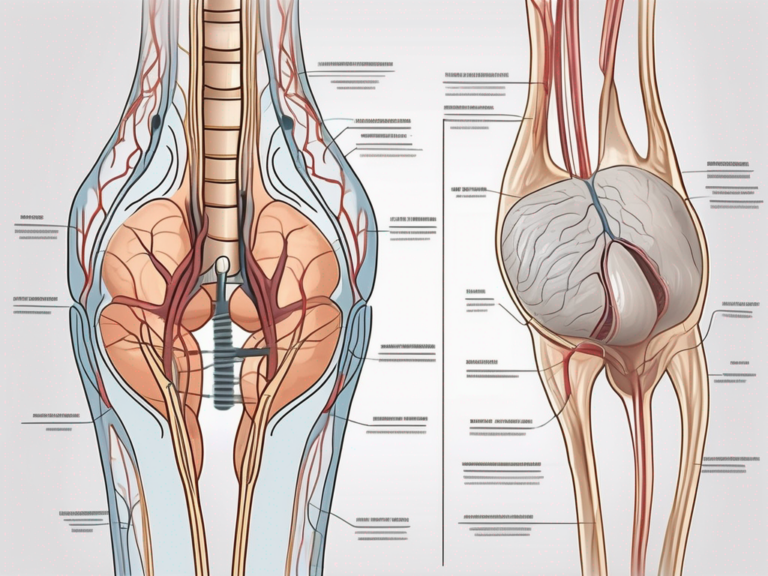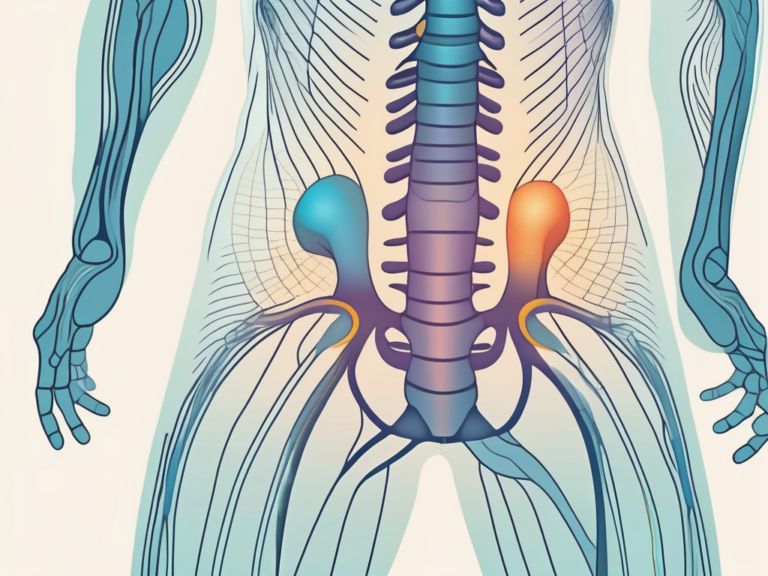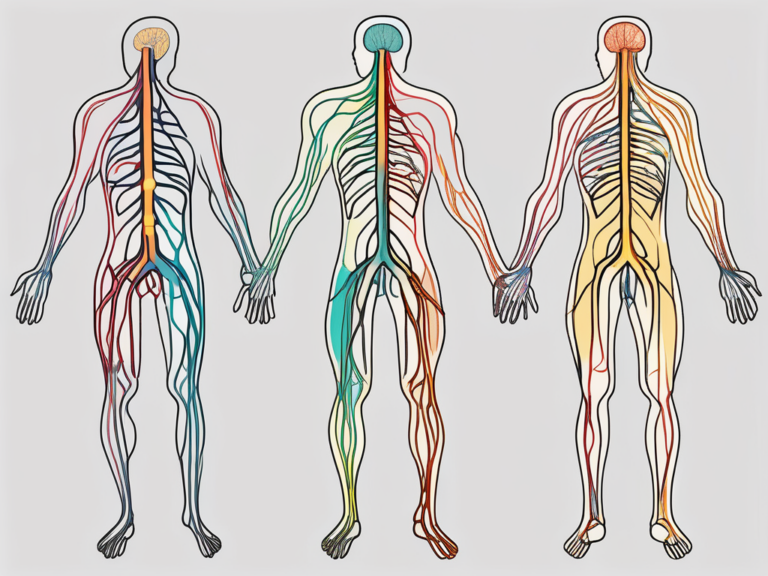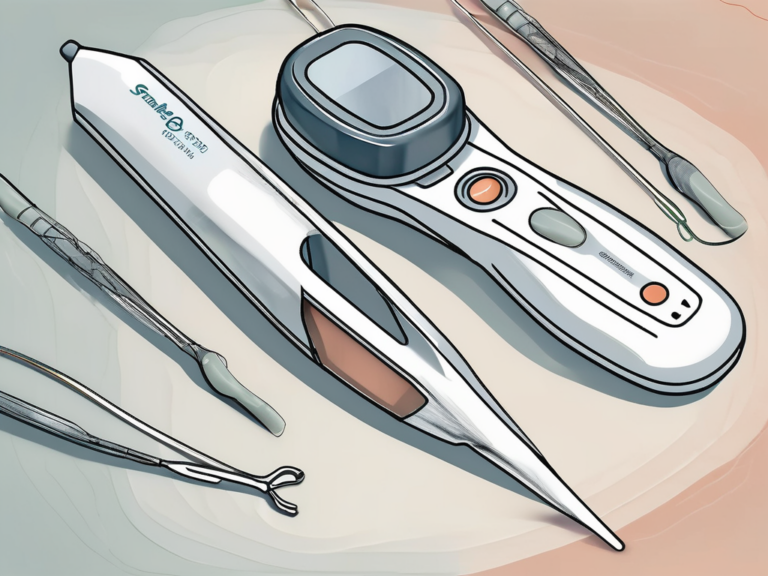What Is Sacral Nerve Stimulation: A Comprehensive Guide
Sacral nerve stimulation is a cutting-edge medical treatment that has revolutionized the field of neuromodulation. It involves stimulating the sacral nerves, which play a crucial role in the functioning of the pelvic region. This comprehensive guide aims to provide you with a thorough understanding of sacral nerve stimulation, its medical applications, the procedure involved, and the risks and benefits associated with it.
Understanding Sacral Nerve Stimulation
The science behind sacral nerve stimulation is fascinating. The sacral nerves are responsible for controlling the bladder, bowel, and sexual functions. By stimulating these nerves with electrical impulses, sacral nerve stimulation can help regulate and restore proper function in these areas. It is a conservative treatment option that is considered when other therapies have not provided adequate relief.
When it comes to the human body, the intricacies of its functioning are truly remarkable. The sacral nerves, located at the base of the spine, hold the key to maintaining a well-balanced pelvic region. These nerves act as messengers, relaying important signals to ensure the smooth operation of bladder contractions, bowel movements, and sexual responses.
The Science Behind Sacral Nerve Stimulation
Sacral nerve stimulation works by delivering low-voltage electrical impulses to the sacral nerves. These impulses act as a catalyst, modulating the nerve activity and helping to alleviate symptoms associated with bladder, bowel, and sexual dysfunction. By precisely targeting the sacral nerves, this innovative treatment option aims to restore normal function and improve the overall quality of life for individuals experiencing these issues.
Imagine a finely tuned orchestra, where each instrument plays its part to create a harmonious melody. Similarly, sacral nerve stimulation orchestrates the intricate dance between the nerves and the organs they control. Through the delivery of electrical impulses, this therapy fine-tunes the communication between the sacral nerves and the bladder, bowel, and sexual organs, allowing for a symphony of proper function.
The Role of Sacral Nerves in the Body
The sacral nerves hold immense importance in the body’s overall functionality. Their role extends beyond mere control of bodily functions; they are the conductors of a complex symphony that ensures the harmonious interplay between the pelvic region and the brain.
When these vital nerves become dysfunctional, it can lead to a range of problems that significantly impact daily life. Individuals may experience an overactive bladder, causing frequent and urgent trips to the restroom. Urinary and bowel incontinence may become a distressing reality, making it challenging to maintain a sense of confidence and independence. Sexual dysfunction and chronic pain can also arise, affecting not only physical well-being but also emotional and mental health.
Understanding the role of sacral nerves in the body helps shed light on the importance of sacral nerve stimulation as a treatment option. By targeting these nerves directly, this therapy aims to restore the delicate balance that allows for proper bladder control, bowel movements, and sexual function.
As medical science continues to unravel the mysteries of the human body, sacral nerve stimulation stands as a testament to the ingenuity and innovation in the field. By harnessing the power of electrical impulses, this treatment option offers hope and relief to individuals struggling with bladder, bowel, and sexual dysfunction.
The Medical Applications of Sacral Nerve Stimulation
Sacral nerve stimulation has shown remarkable effectiveness in treating various medical conditions. Let’s delve into some of the applications:
Treating Urinary and Bowel Disorders
Sacral nerve stimulation has emerged as a game-changer in the treatment of urinary and bowel disorders. It is especially beneficial for individuals with overactive bladder, urge incontinence, fecal incontinence, and chronically constipated bowels. The treatment works by reestablishing control over these functions, improving patients’ quality of life and reducing the need for medication.
Imagine a life where every trip to the bathroom is a source of anxiety and embarrassment. For those with overactive bladder or urge incontinence, this is a daily reality. However, sacral nerve stimulation offers hope and relief. By gently stimulating the sacral nerves, this treatment helps regulate the signals between the brain and the bladder, restoring control and reducing the frequency of accidents.
Similarly, individuals suffering from fecal incontinence can find solace in sacral nerve stimulation. This condition, often accompanied by feelings of shame and isolation, can be effectively managed with this treatment. By targeting the sacral nerves responsible for bowel control, sacral nerve stimulation helps restore normal function and allows individuals to regain their confidence and independence.
Addressing Sexual Dysfunction
Sexual dysfunction can be a sensitive topic for many individuals. Sacral nerve stimulation has shown promise in addressing certain types of sexual dysfunction, such as erectile dysfunction and orgasmic dysfunction. By stimulating the sacral nerves, this treatment can enhance sexual function and restore intimacy for individuals experiencing difficulties in this area.
Intimacy is an essential part of human relationships, but for those struggling with sexual dysfunction, it can feel like an unattainable goal. Sacral nerve stimulation offers a glimmer of hope for individuals facing challenges in their sexual lives. By targeting the sacral nerves involved in sexual function, this treatment can improve blood flow, enhance nerve signaling, and ultimately help individuals regain their sexual confidence and satisfaction.
For men dealing with erectile dysfunction, sacral nerve stimulation can be a game-changer. This condition, often caused by underlying health issues, can significantly impact a man’s self-esteem and relationships. However, by stimulating the sacral nerves, this treatment can improve blood flow to the genital area, leading to stronger and more sustainable erections.
Managing Chronic Pain Conditions
Chronic pain conditions, such as interstitial cystitis, pelvic pain syndrome, and pudendal neuralgia, can be debilitating and severely impact one’s daily life. Sacral nerve stimulation offers a ray of hope for individuals suffering from these chronic pain conditions. By modulating the sacral nerves’ activity, it can provide significant pain relief and improve overall well-being.
Living with chronic pain is a constant battle, both physically and emotionally. However, sacral nerve stimulation can offer much-needed relief for those enduring conditions like interstitial cystitis. By targeting the sacral nerves responsible for pain perception, this treatment can reduce the intensity and frequency of pain episodes, allowing individuals to regain control of their lives.
Pelvic pain syndrome, another chronic pain condition, can also be effectively managed with sacral nerve stimulation. This condition, often characterized by persistent pain in the pelvic region, can greatly impact one’s ability to perform daily activities. However, by modulating the sacral nerves’ activity, this treatment can alleviate pain, improve mobility, and restore a sense of normalcy to individuals suffering from pelvic pain syndrome.
Individuals with pudendal neuralgia, a condition characterized by chronic pain in the pelvic and genital area, can find hope in sacral nerve stimulation. By targeting the sacral nerves involved in pain perception, this treatment can provide significant relief and improve the overall quality of life for those living with pudendal neuralgia.
The Procedure of Sacral Nerve Stimulation
The sacral nerve stimulation procedure is a complex process that involves several key steps, ranging from pre-procedure preparation to post-procedure care. Let’s explore each stage in detail to gain a comprehensive understanding of this treatment option.
Pre-Procedure Preparation
Prior to undergoing the sacral nerve stimulation procedure, a thorough evaluation is conducted to ensure that it is the right treatment option for you. This evaluation typically involves a comprehensive review of your medical history, a detailed physical examination, and various diagnostic tests.
During the medical history review, your healthcare provider will assess your symptoms, previous treatments, and overall health. This information helps them determine whether sacral nerve stimulation is a suitable option for your specific condition.
Following the medical history review, a physical examination is performed to assess your pelvic floor muscles, nerve function, and overall pelvic health. This examination may involve palpation, range of motion tests, and sensory assessments.
In addition to the medical history review and physical examination, diagnostic tests are often conducted to further evaluate your condition. These tests may include urodynamic studies, imaging tests (such as magnetic resonance imaging or computed tomography scans), and nerve conduction studies.
Once the evaluation is complete, your healthcare provider will discuss the sacral nerve stimulation procedure with you in detail. They will explain the potential risks, benefits, and alternatives, allowing you to make an informed decision about your treatment plan. It is essential to openly communicate with your healthcare team and address any questions or concerns you may have.
The Step-by-Step Process
The sacral nerve stimulation procedure typically involves two stages: the trial phase and the implantation phase.
In the trial phase, a temporary electrode is placed near the sacral nerves to assess the potential benefits of stimulation. This is usually done on an outpatient basis, allowing you to return home the same day. The temporary electrode is connected to an external device that delivers electrical impulses to the sacral nerves. This allows you and your healthcare team to evaluate the effectiveness of the treatment in managing your symptoms.
During the trial phase, you will be asked to keep a detailed record of your symptoms and any changes you experience while the electrode is in place. This information is crucial for evaluating the success of the trial and determining whether to proceed with the implantation phase.
If the trial phase is successful and you and your healthcare provider decide to move forward, the implantation phase will be scheduled. In this phase, a permanent electrode is surgically implanted near the sacral nerves. The electrode is connected to a small device called a neuromodulator, which is also implanted under the skin, usually in the buttock area.
The neuromodulator is responsible for delivering the electrical impulses to the sacral nerves, providing the desired therapeutic effect. The device can be programmed and adjusted to meet your specific needs, allowing for personalized treatment.
Post-Procedure Care and Recovery
After the sacral nerve stimulation procedure, you will receive detailed instructions from your healthcare provider regarding post-operative care and recovery. It is crucial to follow these instructions diligently to optimize the outcomes and minimize the risk of complications.
One important aspect of post-operative care is wound care. Your healthcare team will provide guidance on how to keep the surgical incisions clean and properly bandaged. They may also prescribe antibiotics or pain medications to manage any discomfort or reduce the risk of infection.
Activity restrictions are another crucial aspect of post-procedure care. Your healthcare provider will provide specific guidelines on what activities to avoid and for how long. These restrictions may include avoiding heavy lifting, strenuous exercise, or activities that put excessive strain on the surgical site.
Regular follow-up appointments will be scheduled to monitor your progress and make any necessary adjustments to the neuromodulator settings. These appointments allow your healthcare team to assess the effectiveness of the treatment and address any concerns or questions you may have.
In conclusion, the sacral nerve stimulation procedure involves thorough pre-procedure preparation, a step-by-step process that includes a trial phase and an implantation phase, and comprehensive post-procedure care and recovery. By understanding each stage of the procedure, you can make informed decisions and actively participate in your treatment plan.
Risks and Benefits of Sacral Nerve Stimulation
Like any medical procedure, sacral nerve stimulation carries risks and benefits. Let’s have a closer look:
Potential Complications and Side Effects
While sacral nerve stimulation is generally safe, some potential complications and side effects may occur. These can include infection, pain at the implant site, device-related malfunctions, and discomfort during the trial phase. It is crucial to discuss the potential risks with your healthcare provider and address any concerns you may have.
When it comes to infection, the risk can be minimized by following proper hygiene practices and taking prescribed antibiotics. Pain at the implant site is usually temporary and can be managed with pain medication. Device-related malfunctions are rare but can occur. Regular check-ups with your healthcare provider can help identify and address any issues promptly.
During the trial phase of sacral nerve stimulation, some patients may experience discomfort. This is because the trial involves the temporary placement of electrodes to assess the effectiveness of the treatment. It is essential to communicate any discomfort or concerns to your healthcare provider, as adjustments can be made to ensure your comfort.
Success Rates and Positive Outcomes
Sacral nerve stimulation has shown impressive success rates and positive outcomes in many patients. Clinical studies have demonstrated its efficacy in improving bladder and bowel control, reducing urinary and fecal incontinence episodes, relieving chronic pain, and enhancing sexual function. The treatment’s benefits can significantly enhance the quality of life for those who previously struggled with these conditions.
Improving bladder and bowel control is particularly beneficial for individuals with conditions such as overactive bladder or fecal incontinence. It can reduce the frequency and urgency of bathroom visits, allowing for greater convenience and improved social interactions. Additionally, reducing urinary and fecal incontinence episodes can alleviate embarrassment and restore confidence.
For individuals experiencing chronic pain, sacral nerve stimulation can provide much-needed relief. By targeting the sacral nerves, this treatment can help manage pain associated with conditions such as interstitial cystitis, chronic pelvic pain, and pudendal neuralgia. The reduction in pain can lead to improved mobility, better sleep, and an overall improvement in quality of life.
Furthermore, sacral nerve stimulation has been found to enhance sexual function in some patients. By improving nerve signaling and control in the pelvic region, this treatment can address sexual dysfunction caused by nerve damage or other underlying conditions. Restoring sexual function can have a positive impact on intimate relationships and overall well-being.
It is important to note that the success of sacral nerve stimulation may vary from patient to patient. Factors such as the underlying condition, individual anatomy, and overall health can influence the outcomes. Your healthcare provider will assess your specific situation and provide personalized recommendations.
Frequently Asked Questions about Sacral Nerve Stimulation
Here are answers to some common questions about sacral nerve stimulation:
Is the Procedure Painful?
The sacral nerve stimulation procedure is typically performed under anesthesia, ensuring minimal discomfort during the process. However, some patients may experience mild discomfort or soreness at the implant site after the procedure. It is essential to communicate any pain or discomfort to your healthcare provider, who can prescribe appropriate pain management strategies.
During the procedure, a small incision is made in the lower back or buttock area to implant the neuromodulator device. The device is then connected to the sacral nerves, which are responsible for controlling bladder, bowel, and sexual function. The entire process is carefully monitored by a team of medical professionals to ensure safety and efficacy.
After the procedure, patients are typically advised to avoid strenuous activities for a few weeks to allow for proper healing. Your healthcare provider will provide specific instructions on post-operative care and any necessary precautions to take.
How Long Does the Battery Last?
The neuromodulator’s battery life can vary depending on individual usage and settings. Generally, the battery lasts for several years before needing replacement. Your healthcare provider will monitor the device and inform you when it is time for a battery replacement. Regular follow-up appointments are essential to ensure that the device continues to function optimally.
In addition to battery life, the longevity of the sacral nerve stimulation therapy’s effectiveness may also vary among individuals. Some patients may experience long-term relief from their symptoms, while others may require adjustments to the device settings or additional treatments over time. Your healthcare provider will work closely with you to assess your progress and make any necessary modifications to optimize your outcomes.
Can I Undergo Sacral Nerve Stimulation If I Have Other Health Conditions?
Individual suitability for sacral nerve stimulation is determined through a comprehensive evaluation and discussion with your healthcare provider. Certain health conditions or the use of specific medical devices may impact the decision to proceed with the treatment. It is crucial to provide your healthcare team with a complete medical history and disclose any existing health issues or devices.
Some medical conditions that may affect the suitability for sacral nerve stimulation include active infections, bleeding disorders, and certain neurological disorders. Additionally, if you have a pacemaker or other implanted electrical devices, it is important to inform your healthcare provider, as these may interfere with the functioning of the sacral nerve stimulation device.
Your healthcare provider will carefully assess your medical history, perform necessary tests, and discuss the potential risks and benefits of the procedure. They will work with you to determine the most appropriate treatment plan based on your individual circumstances.
In conclusion, sacral nerve stimulation offers a comprehensive and effective treatment option for individuals experiencing bladder, bowel, and sexual dysfunction, as well as chronic pain conditions. If you are interested in exploring this innovative therapy, we strongly recommend consulting with a healthcare professional who specializes in sacral nerve stimulation. They can assess your specific situation, discuss the potential benefits and risks, and guide you towards the most suitable treatment plan.




